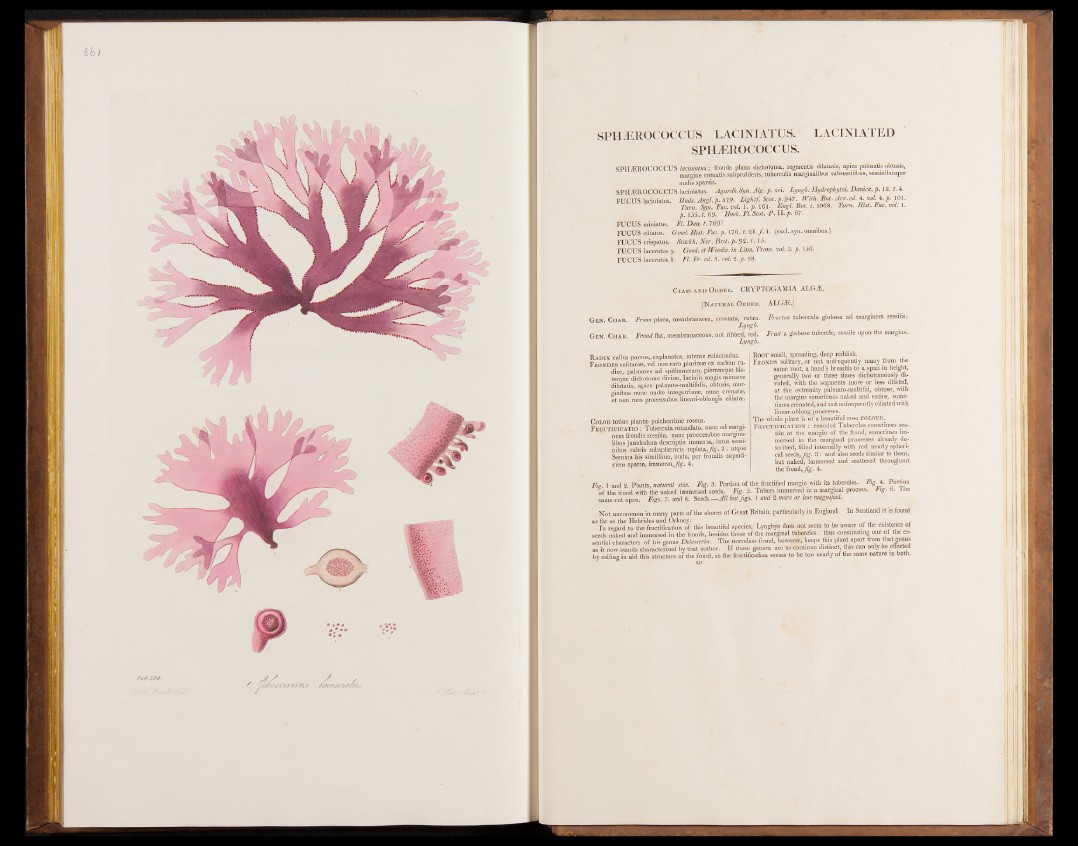
SPHÆROCOCCUS LACINIATUS.
SPHÆROCOCCUS.
LACIN1ATED
SPHÆROCOCCUS laciniatus ; fronde plana dichotoma, segment» dilatatis, apice palmatis obtusis,
margine crenatis subproliferis, tuberculis marginalibus subsessilibus, seminibusque
nudis sparsis.
SPHÆROCOCCUS laciniatus. Agardh Syn. Alg. p. xvi. Lyngb. Hydrophytol. Danica, p . 12. t. 4.
FUCUS laciniatus. Huds. A n g l p . 57.9. Lightf Scot. p. 947. With. Bot. Arr. ed. 4. vol. 4. p. 101.
Turn. Syn. Fuc. vol. 1. p. 161. Engl. Bot. t. 1068. Turn. Hist. Fuc. vol-. 1.
p. 155. t. 69. Hook. Fl. Scot. P . I I . p. 67.
FUCUS miniatus. Fl. Dan. t. 769 ?
FUCUS ciliatus. Gmel. Hist. Fuc. p. 176. t. 2 1 ./. 1. (excl. syn. omnibus.)
FUCUS crispatus. Stackh. N er. B rit. p. 92. t. 15.
FUCUS laceratus y. Good, et Woodw. in Linn. Trans, vol. 3. p. 156.
FUCUS laceratus b. Fl. Fr. ed. 3. vol. 2. p. 28.
Class and Ouder. CRYPTOGAMIA ALGÆ.
[N a tura l Or d e r . ALGAi.]
G e n . Ch a r . Frons plana, membranacea, ecostata, rubra. Fructus tubercula globosa ad marginem sessilis.
Lyngb.
G e n . Ch a r . Frond Bat, membranaceous, not ribbed, red. Fruit a globose tubercle, sessile upon the margins.
Lyngb.
Ra d ix callus parvus, explanatus, in tense rubicundus.
F ronde s solitarise, vel non raro plurimas ex eadem ra-
dice, palmares ad spithamaeam, plerumque bis-
terque dichotome divisas, laciniis magis minusve
dilatatis, apice palmato-multifidis, obtusis, mar-
ginibus nunc nudas integerrimas, nunc crenatas,
e t non raro processubus lineari-oblongis ciliatee.
Color totius plantse pulcherrime roseus.
Fructificatio : Tubercula rotundata, nunc ad marginem
frondis sessilia, nunc processubus marginalibus
jamdudum descriptis immersa, intus semi-
nibus rubris subsphsericis repleta,)?g\ 3 : atque
Semina his simillima, nuda, per frondis superfi-
ciem sparsa, immersa, fig . 4.
Root small, spreading, deep reddish.
Fronds solitary, or not unfrequently many from^ the
same root, a hand’s breadth to a span in height,
generally two or three times dichotomously divided,
with the segments more or less dilated,
at the extremity palmato-multifid, obtuse, with
the margins sometimes naked and entire, sometimes
crenated,and not unfrequently ciliated with
linear-oblong processes.
The whole plant is o f a beautiful rose COLOUR.
F r u c t if ic a t io n : rounded Tubercles sometimes sessile
at the margin o f the frond, sometimes immersed
in the marginal processes already described,
filled internally with red nearly spherical
seeds, jig . 3 : and also seeds similar to them,
but naked, immersed and scattered throughout
the frond, Jig. 4 .
Fig. 1 and 2. Plants, natural size. Fig. 3. Portion of the fructified margin with its tubercles. Fig. 4. Portion
of the frond with the naked immersed seeds. Fig. 5. Tubers immersed in a marginal process, r ig . 6. 1 he
same cut open. Figs. 7. and 8. Seeds.—A ll but figs. 1 and 2 more or less magnified.
Not uncommon in many parts of the shores of Great Britain, particularly in England. In Scotland it is found
as far as the Hebrides and Orkney. I , , .
In regard to the fructification of this beautiful species, Lyngbye does not seem to be aware of the existence of
seeds naked and immersed in the fronds, besides those of the marginal tubercles : thus constituting one of the essential
characters of his genus Delesseria. The nerveless frond, however, keeps this plant apart from that genus
as it now stands characterized by that author. If these genera are to continue distinct, this can only be effected
by calling in aid this structure of the frond, as the fructification seems to be too nearly of the same nature in both.